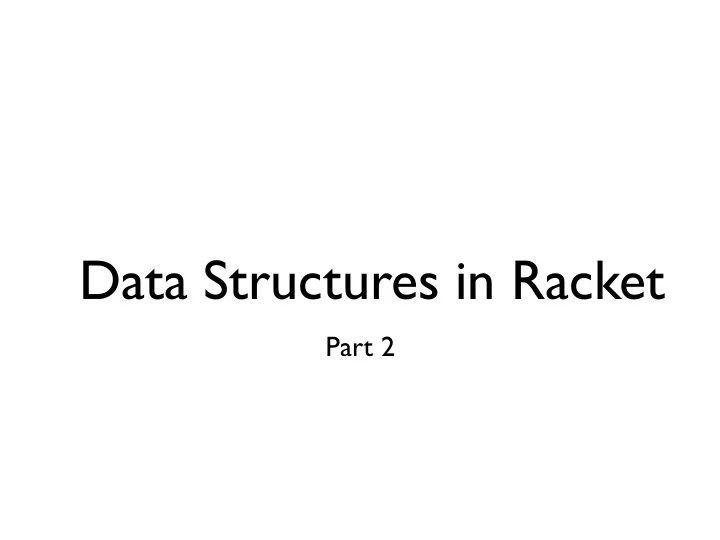

Data Structures in Racket Part 2
Last time
(car (cdr (cons 3 (cons 2 ‘()) ) ) ) 3 2 ‘()
This time
Use struct to define a new datatype
(struct empty-tree ()) (struct leaf (elem)) (struct tree (left right))
Copy these (struct empty-tree ()) (struct leaf (elem)) (struct tree (value left right))
(empty-tree) (leaf 23) (tree 12 (empty-tree) (leaf 23))
Racket automatically generates helpers… tree? tree-left tree-right
Write max-of-tree Use the helpers
Pattern matching
Pattern matching allows me to tell Racket the “shape” of what I’m looking for
Manually pulling apart data structures is laborious
(define (max-of-tree t) (match t [(leaf e) e] [(tree v _ (empty-tree)) v] [(tree _ _ r) (max-of-tree r)]))
Variables are bound in the match, refer to in body (define (max-of-tree t) (match t [(leaf e) e] [(tree v _ (empty-tree)) v] [(tree _ _ r) (max-of-tree r)]))
Note: match struct w/ (name params…) (define (max-of-tree t) (match t [(leaf e) e] [(tree v _ (empty-tree)) v] [(tree _ _ r) (max-of-tree r)]))
Define is-sorted
Can match a list of x’s (list x y z …) (1 2 3 4) x = 1 y = 2 z = ‘(3 4)
Can match cons cells too… (cons x y)
Variants include things like match-let
IO
Racket has a “reader”
(read)
Racket “reads” the input one datum at a time
> (read) (1 2 3) '(1 2 3) > (read) 1 2 3 1 > (read) 2 > (read) 3 >
Read will “buffer” its input
(read-line)
(open-input-file)
Contracts
(define (reverse-string s) (list->string ( reverse (string->list s))))
Write out the call and return type of this for yourself
(define (factorial i) (cond [(= i 1) 1] [else (* (factorial (- i 1)) i)]))
What are the call / return types?
What is the pre / post condition?
(define (gt0? x) (> x 0))
(define/contract (factorial i) (-> gt0? gt0?) (cond [(= i 1) 1] [else (* (factorial (- i 1)) i)]))
Now in tail form…
(define (fac-tail i) (letrec ([h (lambda (i acc) (cond [(= i 0) acc] [else (h (- i 1) (* acc i))]))]) (h i 1)))
Now, let’s say I want to say it’s equal to factorial…
(define/contract (fac-tail i) (->i ([x (>=/c 0)]) [result (x) (lambda (result) (= (factorial x) result))]) (letrec ([h (lambda (i acc) (cond [(= i 0) acc] [else (h (- i 1) (* acc i))]))]) (h i 1)))
(->i ([x (>=/c 0)]) [result (x) (lambda (result) (= (factorial x) result))])
(define/contract (reverse-string s) (-> string? string?) (list->string ( reverse (string->list s))))
(define/contract (reverse-string s) (-> string? string?) (list->string ( reverse (string->list s))))
(<=/c 2)
<=/c takes an argument x , returns a function f that takes an argument y , and f(y) = #t if x < = y
<=/c takes an argument x , returns a function f that takes an argument y , and f(y) = #t if x < = y (Note: <=/c is also doing some bookeeping, but we won’t worry about that now.)
Challenge: write <=/c
Three stories
(define/contract (call-and-concat f s1 s2) (-> (-> string? string?) string? string? string?) (string-append (f s1) (f s2))) (define (reverse-string s) (list->string (reverse (string->list s))))
Scenario: you call call-and-concat with reverse
Scenario: you call call-and-concat with reverse, 12, and “12"
Now define (define/contract (call-and-concat f s1 s2) (-> (-> string? string?) string? string? string?) (length (string-append (f s1) (f s2))))
Now define (define/contract (call-and-concat f s1 s2) (-> (-> string? string?) string? string? string?) (length (string-append (f s1) (f s2)))) What went wrong?
Now define (define/contract (call-and-concat f s1 s2) (-> (-> string? string?) string? string? string?) (length (string-append (f s1) (f s2)))) What went wrong? Who is to blame?
Recommend
More recommend